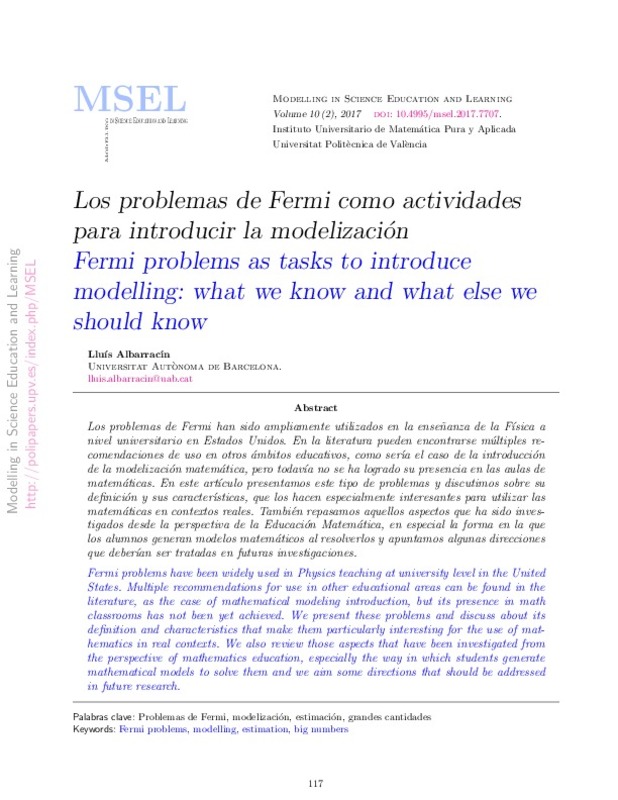Albarracín, L., & Gorgorió, N. (2014). Devising a plan to solve Fermi problems involving large numbers. Educational Studies in Mathematics, 86(1), 79-96. doi:10.1007/s10649-013-9528-9
Albarracín Lluís, Gorgorió Núria (2015a). On the role of inconceivable magnitude estimation problems to improve critical thinking. Educational Paths to Mathematics. Springer, 263-277.
Albarracín Lluís, Lorente Cristina, Lopera, Antoni, Pérez Héctor, Gorgorió Núria (2015b). Problemas de estimación de grandes cantidades en las aulas de Educación Primaria. Epsilon: Revista de la Sociedad Andaluza de Educación Matemática Thales, 32 (89), 19-33.
[+]
Albarracín, L., & Gorgorió, N. (2014). Devising a plan to solve Fermi problems involving large numbers. Educational Studies in Mathematics, 86(1), 79-96. doi:10.1007/s10649-013-9528-9
Albarracín Lluís, Gorgorió Núria (2015a). On the role of inconceivable magnitude estimation problems to improve critical thinking. Educational Paths to Mathematics. Springer, 263-277.
Albarracín Lluís, Lorente Cristina, Lopera, Antoni, Pérez Héctor, Gorgorió Núria (2015b). Problemas de estimación de grandes cantidades en las aulas de Educación Primaria. Epsilon: Revista de la Sociedad Andaluza de Educación Matemática Thales, 32 (89), 19-33.
Albarracín, L., & Gorgorió, N. (2015). A brief guide to modelling in secondary school: estimating big numbers. Teaching Mathematics and its Applications, 34(4), 223-228. doi:10.1093/teamat/hrv006
Albarracín, L., Chico, J., & Guinjoan, M. (2015). Aprendiendo a Enseñar Matemáticas a Partir de la Propia Experiencia. Procedia - Social and Behavioral Sciences, 196, 113-119. doi:10.1016/j.sbspro.2015.07.020
Anderson P. and Sherman C. (2010). A Simplified Method of Fermi Estimation for the Student Innovator. Proceedings of the 14th Annual Conference of the National Collegiate Inventors and Innovators Alliance.
Ärlebäck Jonas Bergman (2009). On the use of realistic Fermi problems for introducing mathematical modelling in school. The Mathematics Enthusiast 6 (3), 331-364.
Ärlebäck Jonas Bergman (2011). Exploring the solving process of groups solving realistic Fermi problem from the perspective of the anthropological theory of didactics. Proceedings of the seventh congress of the European society for research in mathematics education, 1010-1019.
Blum Werner, Leiss Dominik (2007). How do students and teachers deal with modelling problems. Mathematical Modelling (ICTMA 12): Education, Engineering and Economics, 222-231.
Czocher, J. A. (2016). Introducing Modeling Transition Diagrams as a Tool to Connect Mathematical Modeling to Mathematical Thinking. Mathematical Thinking and Learning, 18(2), 77-106. doi:10.1080/10986065.2016.1148530
Fuglestad Anne Berit, Goodchild, Simon (2008). Affordances of inquiry: the case of one teacher. Proceedings of PME32, 3, 49-56.
Joram Elana, Gabriele Anthony J, Bertheau Myrna, Gelman Rochel, Subrahmanyam Kaveri (2005). Children's use of the reference point strategy for measurement estimation. Journal for Research in Mathematics Education, 4-23.
Lesh Richard, Doerr Helen (2003). Foundations of a model and modeling perspective on mathematics teaching, learning, and problem solving. In Beyond constructivism: Models and modeling perspectives on mathematics problem solving, learning, and teaching, 3-33. Lawrence Erlbaum Associates.
Lesh Richard, Hoover Mark, Hole Bonnie Kelly, Anthony and Post Thomas (2000). Principles for developing thought-revealing activities for students and teachers. In Handbook of research design in mathematics and science education, 591-645. Routledge Handbooks Online.
García Navarro Juan Manuel (2013). Problemas de Fermi. Suposición, estimación y aproximación. Revista de la Sociedad Andaluza de Educación Matemática Thales 84, 57-68.
Phillips, R., & Milo, R. (2009). A feeling for the numbers in biology. Proceedings of the National Academy of Sciences, 106(51), 21465-21471. doi:10.1073/pnas.0907732106
Poundstone William (2013). How Would You Move Mount Fuji?: Microsoft's Cult of the Puzzle. How the World's Smartest Companies Select the Most Creative Thinkers. Hachette Book Group.
Reif, F., & St. John, M. (1979). Teaching physicists’ thinking skills in the laboratory. American Journal of Physics, 47(11), 950-957. doi:10.1119/1.11618
Ridgway Jim, Swan Malcolm, Burkhardt Hugh (2001). Assessing mathematical thinking via FLAG. In The teaching and learning of mathematics at university level, 423-430. Springer.
Robinson, A. W. (2007). Don’t just stand there—teach Fermi problems! Physics Education, 43(1), 83-87. doi:10.1088/0031-9120/43/01/009
Schoenfeld Alan H. (1985). Mathematical problem solving. Orlando: Academic Press.
Shakerin Said (2006). The art of estimation. International Journal of Engineering Education, 22 (2), 273-278.
Siegel, A. W., Goldsmith, L. T., & Madson, C. R. (1982). Skill in Estimation Problems of Extent and Numerosity. Journal for Research in Mathematics Education, 13(3), 211. doi:10.2307/748557
Sriraman, B., & Knott, L. (2009). The Mathematics of Estimation: Possibilities for Interdisciplinary Pedagogy and Social Consciousness. Interchange, 40(2), 205-223. doi:10.1007/s10780-009-9090-7
Tangney Brendan, Bray Aibhín (2013). Mobile Technology, Maths Education & 21C Learning. 12th World Conference on Mobile and Contextual Learning, Bloomsbury Qatar Foundation Journals.
Vul, E., & Pashler, H. (2008). Measuring the Crowd Within. Psychological Science, 19(7), 645-647. doi:10.1111/j.1467-9280.2008.02136.x
Wagner, D., & Davis, B. (2010). Feeling number: grounding number sense in a sense of quantity. Educational Studies in Mathematics, 74(1), 39-51. doi:10.1007/s10649-009-9226-9
Weiss Laura (2013). Les Questions de Fermi. Math-École 219, 41-47.
Weinstein Lawrence, Adam John A (2009). Guesstimation: Solving the world's problems on the back of a cocktail napkin. Princeton University Press.
Weinstein, L. (2012). Guesstimation 2.0. doi:10.1515/9781400844661
White, H. B. (2004). Math literacy. Biochemistry and Molecular Biology Education, 32(6), 410-411. doi:10.1002/bmb.2004.494032060415
Zawojewski Judith S., Lesh Richard A., English Lyn D (2003). A models and modeling perspective on the role of small group learning activities. In Beyond constructivism: Models and modeling perspectives on mathematics problem solving, learning, and teaching, 337-358. Lawrence Erlbaum Associates.
[-]








